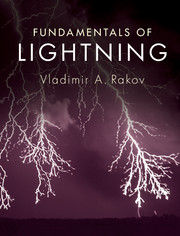Book contents
- Frontmatter
- Dedication
- Contents
- Preface
- 1 Types of lightning discharges and lightning terminology
- 2 Incidence of lightning to areas and structures
- 3 Electrical structure of thunderclouds
- 4 Properties of the downward negative lightning discharge to ground
- 5 Calculation of lightning electromagnetic fields
- 6 Modeling of the lightning return stroke
- 7 Measurement of lightning electric and magnetic fields
- 8 Electromagnetic methods of lightning location
- 9 Lightning damaging effects and protective techniques
- Appendices
- References
- Index
1 - Types of lightning discharges and lightning terminology
Published online by Cambridge University Press: 05 April 2016
- Frontmatter
- Dedication
- Contents
- Preface
- 1 Types of lightning discharges and lightning terminology
- 2 Incidence of lightning to areas and structures
- 3 Electrical structure of thunderclouds
- 4 Properties of the downward negative lightning discharge to ground
- 5 Calculation of lightning electromagnetic fields
- 6 Modeling of the lightning return stroke
- 7 Measurement of lightning electric and magnetic fields
- 8 Electromagnetic methods of lightning location
- 9 Lightning damaging effects and protective techniques
- Appendices
- References
- Index
Summary
Lightning can be defined as a transient, high-current (typically tens of kiloamperes) electric discharge in air whose length is measured in kilometers. As for any discharge in air, the lightning channel is composed of ionized gas – that is, of plasma – whose peak temperature is typically 30,000 K—about five times higher than the temperature of the surface of the Sun. Lightning was present on Earth long before human life evolved, and it may even have played a crucial role in the evolution of life on our planet. The global lightning flash rate is some tens per second to 100 per second. Each year, some 25 million cloud-to-ground lightning discharges occur in the United States, and this number is expected to increase by about 50 percent due to global warming over the twenty-first century (Romps et al., 2014). Lightning initiates many forest fires, and over 30 percent of all electric power line failures are lightning related. Each commercial aircraft is struck by lightning on average once a year. A lightning strike to an unprotected object or system can be catastrophic.
Overview
The lightning discharge in its entirety, whether it strikes the ground or not, is usually termed a “lightning flash” or just a “flash.” A lightning discharge that involves an object on the ground or in the atmosphere is referred to as a “lightning strike.” A commonly used non-technical term for a lightning discharge is a “lightning bolt.” About three quarters of lightning discharges do not involve the ground. They include intracloud, intercloud, and cloud-to-air discharges and are collectively referred to as cloud flashes (see Fig. 1.1) and sometimes as ICs. Lightning discharges between cloud and earth are termed cloud-to-ground (or just ground) discharges and sometimes referred to as CGs. The latter constitute about 25 percent of global lightning activity. About 90 percent or more of global cloud-to-ground lightning is accounted for by negative downward lightning, in which negative charge is effectively transported to the ground, and the initial process begins in the cloud and develops in the downward direction. The term “effectively” is used to indicate that individual charges are not transported all the way from the cloud to the ground during the lightning processes; rather, the flow of electrons (the primary charge carriers) in one part of the lightning channel results in the flow of other electrons in other parts of the channel.
- Type
- Chapter
- Information
- Fundamentals of Lightning , pp. 1 - 16Publisher: Cambridge University PressPrint publication year: 2016
- 1
- Cited by



